A History Of Hertfordshire's Mounted Men 1900 - 1928
Mounted Policeman And Their Role In Policing The County
Paul Watts
The topic of this article is the history of use of horses by the Hertford County Constabulary. The information and photographs are drawn from the Hertfordshire Police Historical Society archive and in particular a series of General Orders. These detail specific events which Mounted Police Officers were instructed to attend and often, as well as naming the individual officers, the names of their horses were also given. These are just a few examples of the numerous similar Orders that exist.
The first photograph is not associated with any surviving General Order but is believed to be the earliest picture of Hertfordshire Mounted Officers being used. It is thought to show them escorting the competitors of a walking race c. 1900 in Watford.
Mutual Aid.
General Order 17 of the 4th April 1901 is an example of the earliest use of Mutual Aid, under the Police Act 1890, between different Police Forces where horses were required. The Herts County Constabulary were asked to support the Essex Police at the Essex Hunt Steeple Chases at High Roothing Bury on 11th April 1901. The following party of Mounted Police were detailed for duty: Sgt. Alfred Chisman 37 A Division on Walnut (in charge), PC William Allen 62 C Division on Lady Bird, PC John Moles 137 E Division on Portsmouth, PC William Bethell 233 F Division on Chance Shot and PC Percival Hair 167 R Division on Topthorn.
The second photograph shows PC 233 William Bethell riding Chance Shot. Many of the horse racing events were held annually and there are numerous other examples. There were no logistical instructions and it is assumed they followed a similar procedure every time.
General Order 20 of the 5th May 1901 was another example and gave instructions to a Sergeant and three Constables for Mounted duties at the Herts Pony and Galloway Races which were held at Beech Bottom between the Harpenden to Sandridge Roads St. Albans on Thursday 16th May 1901. The following were detailed: Sgt. George Reed 61 E Division on Headquarters Horse Night Jar, PC William Allen 62 C Division on Lady Bird, PC William Bethell 233 F Division on Chance Shot and PC Arthur Hughes 116 R Division on Tounny.
The Assizes.
General Order 28 of the 21st June 1901 is an example of the opening of the Hertford Assizes. It ordered the following Mounted Detachment to parade at Hertford at 12 noon on 25th June 1901 as Judges Escort. Sgt. 37 Alfred Chisman on Ware Horse, PC 62 William Allen on Hoddesdon Horse, PC 116 Arthur Hughes on St Albans Horse, PC 167 Percival Hair on Criff, PC 179 Alfred Field on Bishops Stortford Horse and PC 233 William Bethell on Hertford Horse.
PC’s Hughes and Field were told to remain at Hertford until the Assizes are over. Sgt. Chisman, PC’s Allen and Hair were told to return to their stations each evening. The escort was required again on the morning of the 26th inst. and every day until the conclusion of the Assizes. They were told that swords with white belts would be worn but not drawn. Supt. Shore had to make arrangements for stabling for the outstationed horses. The officers were told not to charge any special duty for attending the Assizes as they would receive the same from Headquarters. PC’s 45 Waller and 155 Taylor were instructed to be at Hertford on 25th inst. at 12 noon to act as Trumpeters and to remain until the Assizes were completed and to perform duty in the court under Supt. Shore’s orders.
The third photo shows the arrival of the Judge at the Assizes in 1910 and it would appear that little had changed in the way of how things were conducted. The Mounted officers are, starting with the man nearest the Trumpeters and working left to right, PC 39 Francis Adams, PC 183 Robert Pusey, PC 148 Joseph Huggins, Sgt. 137 John Moles, PC 212 Samuel Lambert and PC 234 Harry Inwood.
Watford Riots.
There are no Orders which have survived concerning the events which occurred on the 26th June 1902. It should have been Coronation Day, but the King was seriously ill with an appendicitis and the expected celebrations were cancelled. Groups of drunken individuals who took exception to this started rioting. The Riot Act was read in Watford and several offenders were arrested. The fourth photograph shows some of the rioters, under Mounted Police escort, on their way to St. Albans gaol.
Reorganisation Of The Mounted Police.
General Order 20 of the 8th October 1902 was an Order by the Chief Constable, Lieutenant Colonel Henry Smith Daniell, which reorganised the Mounted Police in Hertfordshire and stated that the following list would comprise the ordinary Mounted Police Force of the County:
Superintendent Henry Duke
Inspector George Reed
PC 61 William Stevens
PC 179 Alfred Field
PC 148 Joseph Huggins
PC 212 Chisman
PC 199 Joseph Briden
PC 233 William Bethell
PC 167 Percival Hair
PC 116 Arthur Hughes
PC 55 Frederick Warren
PC 137 John Moles
PC Moles was told to wear Acting Sergeant stripes on his mounted tunic and cloak and to act as Sergeant when mounted. Two Sergeants and ten Constables were selected to form a Mounted Police Reserve. They would be utilised as Mounted Police on horses which would be provided for them when necessary. They would be provided with a complete mounted kit which they had to keep by them, and they had to parade in mounted order once in every month before the Superintendent who had to report their kit as complete and in good repair. Their saddlery would be kept at their Divisional Superintendents Station and the Superintendent’s Groom would be responsible for it being kept clean and in good order when not in use. It would be cleaned and stowed away by the Mounted Reserve man after use.
Superintendents were told to submit the names of Sergeants and Constables fit for this duty giving preference to Cavalry, Horse Artillery and Mounted Infantry men.
Elections.
General Order 4 of the 6th February 1904 gave orders regarding the Policing of the Mid Herts Parliamentary Bye Election by Mounted Police Officers. Detailed for duty on Friday the 12th February 1904 at Harpenden were PC 212 Chisman D Division on horse Gold Dust, at Markyate PC 199 Joseph Briden D Division on horse Velvet and at Wheathampstead PC 116 Arthur Hughes G Division on horse Stella.
For duty at St. Albans were Supt. Henry Duke A Division on horse The Butcher, PC 137 John Moles (Acting Sgt) A Division on horse Ladysmith, PC 233William Bethell B Division on horse Walnut, PC 11 Charles Pearman E Division on horse Erith and PC 39 Francis Adams F Division on horse Chance Shot.
The Parliamentary Elections of 1906 were held over several days and were a huge logistical problem regarding supplying sufficient men and horses. Schedule E of the Orders referred to the Mounted Police and where and when they would be on duty.
At St. Albans on Wednesday 17th January there were fourteen Officers, mostly riding Police owned horses, led by Inspector George Reed on a horse owned by a Mr Collins. Of interest also was that PC 233 William Bethell was on a horse owned by a Mr Royds and PC 62 William Allen was on the Watford Weights & Measures horse and PC 249 Archibald Burns was on the Hertford Weights & Measures. During this period one of the County’s Policing responsibilities was the testing for accuracy of measuring and weighing equipment used by traders. To carry out these duties there were clearly two horses specifically allocated to the role.
For the following day at St. Albans there were a total of nineteen Mounted Officers with the extra five all riding hired horses. The Superintendents had to arrange for each man to take his saddlery by the first train to the place where he would find his horse when necessary.
For duty at Hertford on Friday 19th January the original fourteen men detailed for the 17th January, except those from St Albans, were ordered to come into Hatfield on the night of the 18th. With some additions in personnel there were again nineteen Mounted Officers on duty on the 19th and again on the 20th.
On Monday the 22nd the whole mounted Police Force in Hertford under Inspector Reed were ordered to march from Hertford to Watford or Hemel Hempstead as instructed ready for Tuesday 23rd and Wednesday 24th. An additional five Mounted Officers were made available for Hemel Hempstead and at Great Berkhampstead. Some of them, were ordered to Watford on the 24th, providing they could be spared by Supt. Frogley.
The fifth photograph shows a Mounted man, possibly Supt. Duke, on duty at Watford at the declaration of the count.
On the morning of the 25th, the whole of the Mounted Police, excepting Sgt. Page, PC’s Hair, Huggins and Bolton, were ordered to proceed from Watford to Hitchin by rail. Supt. Wood was instructed to arrange for horse boxes and Inspector Reed was responsible for the horses being boxed in good time.
On the 26th January, the disposition of the Mounted men in Hitchin and elsewhere in the Division was left to the Deputy Chief Constable. When the Mounted men were relieved from duty Inspector Reed was ordered to see that they marched to wherever their horse was needed on Saturday 27th.
On the 4th July 1905 Constable James Woolnough was transferred from R Division to A Division with Police Horse Dancing Master as Mounted Patrol at Hoddesdon.
More Mutual Aid.
General Order 4 of the 14th March 1906 is another example of Mutual Aid to another Constabulary, this time Buckinghamshire. A Mounted Detachment of one Sergeant and seven Constables were ordered to perform duty at the Aylesbury Races on the 5th April 1906. Initially they were told to perform duty at the Herts Hunt Steeplechases at Annables Farm near Redbourn after which overnight stabling would be provided at Tring. They were told to leave Tring at 8.30 on the morning of the 5th April for Aylesbury and were told to report to the Chief Constable of Buckinghamshire at 11 a.m. Stabling would be provided at the Kings Head Hotel.
Once relieved from duty in Aylesbury they were told to return to Tring and remain the night there and then return to their own stations on the 6th April. They were also each told to complete a Special Duty Report Form 115 from the time they left Annables Farm on the 4th April to the time they arrived at their respective stations and to submit it as soon as possible.
The Coronation.
General Order 19 of 14th June 1911 gave instructions for one Sergeant and twenty Constables, all Mounted Officers with the majority on hired horses, to be on duty on the 22nd June 1911 at various locations around the county for the coronation of George V and Mary of Teck as King and Queen of the United Kingdom and the British Empire.
Superintendents were at liberty to detail the Mounted men ordered within their own Divisions to do ordinary duty other than Mounted Duty if they thought fit. The Chief Constable was however, of the opinion that on a day like the Coronation Day, and with the crowds, one Mounted Constable was worth three on foot, and the Mounted Constable moreover would be in a position to go speedily to any part of the Division or County where any sort of disturbance might occur. As far as possible Territorial or Yeomanry Horses would be hired.
More Mutual Aid.
General Order 16 of the 1st July 1911 ordered one Inspector, four sergeants and twenty five Constables to proceed to Cardiff, South Wales on Wednesday 5th July 1911 for duty at Gilfach Goch Colliery. The sixth photograph is of PC 47 James Woolnough, although not mentioned in this order, he is said to have been on duty at Gilfach Goch.
Further Reorganisation of the Mounted Police.
Lieutenant Colonel Alfred Letchworth Law Chief Constable issued General Order 17 of the 31st January 1923 confirming the establishment of the Hertfordshire Mounted Police from the 1st February 1923 would consist of the undermentioned Sergeant and Constables:
Rank & No. Name Division Station
1. PS 35 Amos Reid C Watford
2. PC 199 Joseph Briden A Braughing
3. PC 111 George Sweetland A Bishops Stortford
4. PC 93 Frank Potton B Hertford
5. PC 315 Walter Thurley B Hertford
6. PC 331 George Kimpton C Watford
7. PC 282 Arthur Eames E Kimpton
8. PC 200 Arthur Bangs E Hitchin
9. PC 212 Samuel Lambert R Headquarters
10. PC 78 Ernest Phypers R Headquarters
11. PC 233 Arthur Howe R Headquarters
Officers who had Mounted Equipment but were not included in the Mounted Establishment shown above were told to hand such equipment into stores forthwith.
General Order 127 of the 21st July 1923 instructed Mounted Officers to perform duty at the Herts Agricultural Show which was held at Hatfield Park on Thursday 26th July 1923. Constable 282 Arthur Eames was told to proceed to Headquarters on morning of the 26th July and take over Headquarters horse Banny Ally and then return to his station the same evening. Constable 212 Samuel Lambert was told to ride the Headquarters horse Greig. The seventh photograph is of PC Lambert.
A Change In Policy.
In complete contrast General Order 68 of the 14th April 1924 instructed four Mounted Officers to perform duty at Colonel Part’s Harriers Private Point to Point Steeplechases which were held at Annables Farm near Redbourn on Wednesday 16th April 1924. Instead of using Police horses all four horses were provided by the Hunt. The detachment were told to take over their horses at Annables Farm at 9 a.m. and report on the race ground at 9.30 a.m. The Superintendent D Division was told to arrange for four sets of saddlery to be taken there on Tuesday 15th April 1924. For most of the following similar events the Police were provided with horses by the organisers.
The Assizes.
General Order 88 of the 8th June 1925 announced that the Hertfordshire Summer Assizes would be held at the Shire Hall Hertford commencing at 11 a.m. on Wednesday 17th June 1925. Five Officers formed the Mounted Detachment consisting of Sergeant 35 Amos Reid C Division, PC 315 Walter Thurley C Division, PC 339 Thomas Oliver B Division all riding hired horses and PC 212 Samuel Lambert R Division riding Marvel and PC 233 Arthur Howe R Division riding Greig.
The hired horses were supplied by Mr Wells of Stanstead Abbotts. Superintendent A Division had to arrange two complete sets of saddlery to be delivered at the premises of Mr. Wells on the morning of 16th June 1925. Constable 339 Oliver was to take saddlery from Hoddesdon Police Station. Sergeant Reid, PC Thurley and PC Oliver had to report at Stanstead Abbotts at 2 p.m. on Tuesday 16th June 1925 for riding exercise and then report at Hertford Police Station at 9.30 a.m. on Wednesday 17th June 1925 for duty.
Sergeant Reid and PC Thurley were to remain at Stanstead Abbotts on the night of 16th June and following nights until the Assizes were over. PC Oliver had to return to his station each night. PC’s Lambert and Howe had to march from Headquarters to Hertford arriving each day at 9.30 a.m. before returning home each night.
The Judge and High Sheriff were to use horse drawn carriages. Sergeant Reid had to arrange for the Mounted Police to act as an escort to the carriages on all occasions they were used during the Assizes. The Order of March was to be the Police Sergeant followed by two Constables abreast at a distance of approximately 8 yards and were to precede the first carriage. Two Constables abreast were to follow the rear carriage at a distance of approximately 8 yards.
The Beginning Of The End For Horses – The Arrival Of The Motor Car.
General Order 149 of the 3rd November 1926 announced that the Hertfordshire Autumn Assizes would be held at the Shire Hall Hertford commencing at 11 a.m. on Friday the 19th November 1926. Only three Officers now formed the Mounted Detachment consisting of Sergeant 35 Amos Reid B Division riding Greig, PC 136 Archibald Seal E Division riding Marvel and PC 212 Samuel Lambert R Division riding Derry.
PC Seal was told to march from Hitchin to Hertford on the 18th November 1926 and remain until the Assizes are over. Superintendent B Division would arrange for the stabling of the horse. Sergeant Reid and PC Lambert were told to march direct from Headquarters to Hertford Police Station on Friday 19th November 1926 arriving at 9.30 a.m. and return home each night.
The Judge and High Sheriff would use motor cars in Hertford. Sergeant Reid will arrange for the Mounted Police to act as an escort to the motor cars, under instructions from Superintendent B Division. The Order of March was to be Sergeant Reid preceding the motor car. PC’s Lambert and Seal abreast were to follow the motor car at a distance of approximately 6 yards.
By 1928 the Mounted Detachment within Hertfordshire Police ceased to exist but many of the men went on to become Motor Drivers.

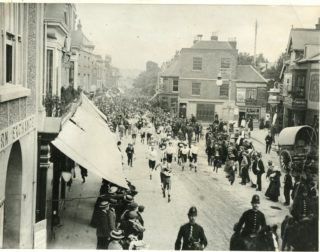
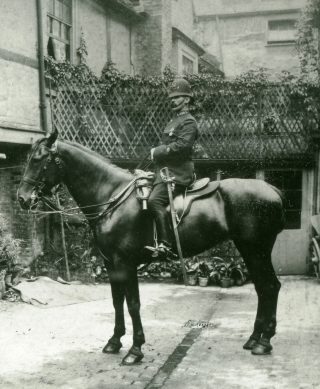
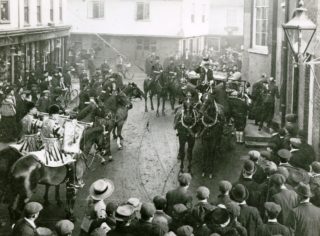
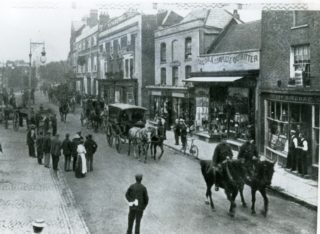
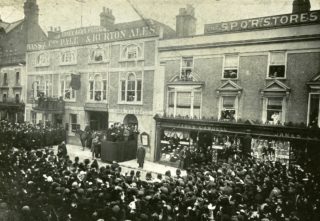
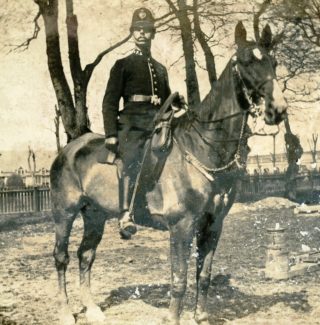
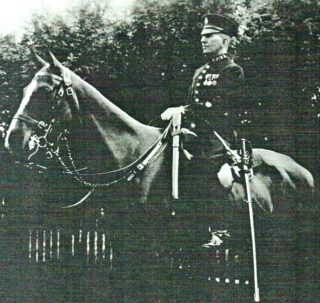








Add your comment about this page